Concurs local pentru a selecta 3 simboluri naționale
Ghidați de profesoara lor de arte, elevii Liceului Teoretic ”Constantin Noica” Sibiu, România au început să deseneze pentru a descrie prin intermediul imaginației simbolurile naționale românești. Trei dintre cele mai bune desene au fost selectate pentru a fi prezentate în timpul mobilității din România și pentru a crea afișul proiectului. Am creat o prezentare PowerPoint cu ele folosind două fotografii pentru fiecare diapozitiv. Apoi, folosind Slideshare, am creat materialul postat aici. Profesoara de arte a fost foarte mândră de desenele elevilor și de ideea lor de a folosi propriile desene pentru a-și prezenta simbolurile naționale, nu imaginile de pe internet. Ei și-au îmbunătățit în acest fel abilitățile de artă.
Mădălina Sporiş, profesor, Liceul Teoretic "Constantin Noica", Sibiu

Journey from Past to Today
Culture is the characteristics and knowledge of a particular group of people, encompassing language, religion, cuisine, social habits, music and arts. In other words, culture is the reflection of social life sometimes on paper and sometimes on behavior. Our children are the mirror of our culture and the elements that will pass on our traditions to other generations. Vali M. Lütfullah Bilgin Secondary School, within the framework of Erasmus+ program, participated in the exhibition “Folk Culture and Traditional Gaziantep Clothes” prepared by kindergarten students in order to introduce our traditions, customs and the change of social life over time, to our students. In the exhibition, Our students saw traditional Gaziantep clothes on dolls prepared by kindergarten teachers and students and gained new information about folk culture. Müberra Durak and Erkan Demirci, deputies and members of the project team, accompanied our students in the exhibition, which was very enjoyable and educational.

Erkan Demirci, deputy in Vali M. Lütfullah Bilgin Secondary School, Gaziantep, Turkey
https://www.facebook.com/erkan.demirci.5074/videos/2707019639358214/
Geçmişten Günümüze Yolculuk
Kültür, dil, din, mutfak, sosyal alışkanlıklar, müzik ve sanatları kapsayan belirli bir grup insanın özellikleri ve bilgisidir. Başka bir deyişle, kültür; toplumsal yaşamın kimi zaman kağıt üzerine, kimi zaman da davranışlara yansımasıdır. Çocuklarımız, kültürümüzün aynası olup gelenek göreneklerimizi diğer kuşaklara aktaracak olan unsurlardır. Vali M. Lütfullah Bilgin Ortaokulu, Erasmus+ programı çerçevesinde, geçmişten günümüze geleneklerimizi, adetlerimizi ve toplumsal yaşamın zaman içindeki değişimini öğrencilerimize tanıtmak amacıyla, anaokulu öğrencileri tarafından hazırlanan “Halk Kültürü ve Geleneksel Gaziantep Kıyafetleri” adlı sergiye katılmıştır. Sergide, öğrencilerimiz anaokulu öğretmen ve öğrencilerinin hazırladığı oyuncak bebekler üzerinde geleneksel Gaziantep kıyafetlerini görüp halk kültürü hakkında yeni bilgiler edinmişleridir. Oldukça zevkli ve eğitici geçen sergide öğrencilerimize, müdür yardımcıları ve proje ekibi üyelerinden Müberra Durak ve Erkan Demirci eşlik etmiştir.
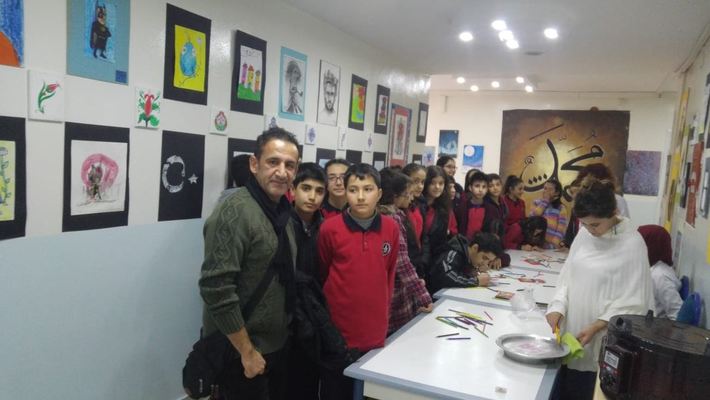
Müberra Durak, müdür yardımcısı Vali M. Lütfullah Bilgin Ortaokulu, Gaziantep, Türkiye
Celebrating 170 Years from Our National Poet’s Birth
Mihai Eminescu was a Romantic poet, novelist, and journalist, generally regarded as the most famous and influential Romanian poet, as well as the first modern poet in Romanian literature. His most known poem was ”Lucifer”. That’s why we called him ”the lucifer of the Romanian poetry” or ”our national poet”. On January 15th 2020, the pupils of the 10th grade in ”Constantin Noica” Theoretical High School Sibiu have celebrated 170 years from his birth by reading some of his poems and talking about his work.
Gabriela Mirela Jugar, coordinator, ”Constantin Noica” High School Sibiu


Sărbătorind 170 de ani de la nașterea poetului nostru național
Mihai Eminescu a fost un poet, romancier și jurnalist romantic, considerat în general cel mai cunoscut și influent poet român, precum și primul poet modern din literatura română. Cel mai cunoscut poem al său a fost „Lueafărul”. De aceea noi l-am numit „luceafărul poeziei românești” sau „poetul nostru național”. Pe 15 ianuarie 2020, elevii clasei a 10-a de la Liceul Teoretic „Constantin Noica” Sibiu au sărbătorit 170 de ani de la nașterea lui, citind o parte din poeziile sale și discutând despre opera sa.
Petrina Dobrotă, profesor, Liceul ”Constantin Noica” Sibiu, România

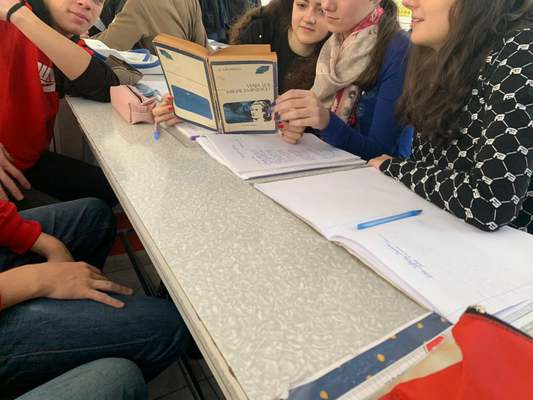
The Meetings of with Our Pupils' Parents
On 14/11/2019, the 2nd Parent-Teacher Meeting for the Erasmus program took place. Students and teachers who participated in the program shared with their parents and classmates the experiences they gained from the meeting held on 20-26 / 10/2019 in Nidjika, Poland. At the same time, the first update on the upcoming trip to the city of Sibiu, Romania was made on 30 / 11-07 / 12/2019.
Eleni Omerou, coordinator, Gymnasium Apostolou Paulou, Cyprus

Oi synantíseis me tous goneís ton mathitón mas
Stis 14/11/2019, pragmatopoiíthike i 2i synántisi gonéon-kathigitón gia to prógramma Erasmus. Oi mathités kai oi kathigítries pou symmeteíchan sto prógramma, moirástikan me tous goneís kai tous symmathités tous tis empeiríes pou apokómisan apó ti synántisi pou pragmatopoiíthike stis 20-26/10/2019 sti póli Nidjika, Polonía. Parállila égine kai i próti enimérosi gia to epikeímeno taxídi sti póli Sibiu, Roumanía stis 30/11-07/12/2019.
Gabriella Theodosiou , dáskalos, Gymnásio Apostólou Pávlou, Páfos

Preparing decorations…
As part of the project activities, we were supposed to decorate the school with elements specific to partner countries. We started decorating before the arrival of our international guests to our school. "Erasmus Hall" has a new layout. Partner country flags, school information and important project information is displayed. After the visit of our partners, the school cupboards became an exhibition for handicrafts made by participants of pottery workshops, and the wall was decorated with wonderful paintings. It was complemented by a set of snowmen, on which our students wrote basic phrases in all languages of partner countries, and of course in English as the target language joining all of us. The heads of the Snowmen show the national colors of all partners implementing our folklore adventure with us as part of the 'Folklorica' Erasmus+ 2019-2021 project. The snowmen decorate our school's lobbies and remind us of the snow, which we definitely lack this year.
Mariola Podolska-Maculewicz, project coordinator; Szkoła Podstawowa Nr 2 z Oddziałami integracyjnymi im. Michała Kajki w Nidzicy, Poland


Przygotowuję dekoracje…
W ramach działań projektowych mieliśmy za zadanie udekorować szkołę elementami charakterystycznymi dla krajów partnerskich. Dekorowanie rozpoczęliśmy już przed przyjazdem zagranicznych gości do naszej szkoły. „Hol Erasmusa” przybrał nową szatę graficzną. Zawisły flagi krajów partnerskich, informacje o szkołach oraz ważne informacje dotyczące projektu. Po wizycie naszych partnerów szafki szkolne stały się wystawką dla rękodzieła wykonanego przez uczestników warsztatów garncarskich, a ścianę ozdobiły wspaniałe obrazy. Dopełnieniem był zestaw bałwanków, na których „Nidzickie Erasmusiaki” wypisały zwroty grzecznościowe we wszystkich językach projektowych no i oczywiście w języku angielskim będącym łącznikiem między wszystkimi partnerami. Głowy Bałwanków przedstawiają barwy narodowe wszystkich partnerów realizujących z nami naszą folklorystyczną przygodę w ramach projektu ‘Folklorica’ Erasmus+ 2019-2021. Bałwanki zdobią hole naszej szkoły i przypominają o śniegu, którego w tym roku zdecydowanie nam brakuje.
Miros lawa Kaszubska, nauczyciel; Szkoła Podstawowa Nr 2 z Oddziałami integracyjnymi im. Michała Kajki w Nidzicy, Poland

Learning Traditional Dances and Songs
After a short research on traditional dances we got to know the steps and learnt how to dance. As a result we recorded a short video with the effect of our effort - “Polonez”- a traditional dance beginning the prom night. At first looking at our eager teachers having so much fun trying to engage and encourage the young dancers made them feel a bit ashamed but after a while the pupils got the hang of it and followed the instructors’ mood. Another task which helped us come back to our roots was looking for a folk song for our project partners to learn. The best part of this task with a lot of laughter was trying to sing our partners’ songs in their native languages basing on the phonetic transcription of the lyrics which appeared to be real tongue twisters for us. The winner of the song contest in our school was the one of our Lithuanian friends “Žemyn upe” and this is the song we are going to sing during the international contest. To make dancing and singing traditional songs more interesting for pupils we designed and made musical instruments which were commonly used in the past out of available waste materials. It was a real challenge for us. Fortunately with the help of relatives we managed to fulfil the task and had fun trying to play them.
Mariola Podolska-Maculewicz, Gimnazjum Nr 2 z Oddziałami integracyjnymi im. Michała Kajki, project coordinator


Nauka tradycyjnych tańców i pieśni
Po krótkim badaniu tradycyjnych tańców poznaliśmy kroki i nauczyliśmy się tańczyć. W rezultacie nagraliśmy krótki film z efektem naszego wysiłku - „Polonez” - tradycyjny taniec rozpoczynający noc balu maturalnego. Na początku patrząc na naszych chętnych nauczycieli, którzy bawili się tak dobrze, próbując zaangażować i zachęcić młodych tancerzy, poczuli się nieco zawstydzeni, ale po chwili uczniowie zrozumieli i podążali za nastrojem instruktorów. Kolejnym zadaniem, które pomogło nam wrócić do korzeni, było poszukiwanie piosenki ludowej dla naszych partnerów projektu. Najlepszą częścią tego zadania z dużą ilością śmiechu była próba zaśpiewania piosenek naszych partnerów w ich ojczystych językach w oparciu o fonetyczną transkrypcję tekstów, które wydawały się nam prawdziwymi twistami językowymi. Zwycięzcą konkursu piosenki w naszej szkole został jeden z naszych litewskich przyjaciół „Žemyn upe” i jest to piosenka, którą zaśpiewamy podczas międzynarodowego konkursu. Aby uczynić tańce i śpiewanie tradycyjnych piosenek bardziej interesującymi dla uczniów, zaprojektowaliśmy i wykonaliśmy instrumenty muzyczne, które były powszechnie używane w przeszłości z dostępnych materiałów odpadowych. To było dla nas prawdziwe wyzwanie. Na szczęście z pomocą krewnych udało nam się wykonać zadanie i dobrze się bawiliśmy, próbując w nie zagrać.
Iwona Nasiadka, nauczyciel, Szkoła Podstawowa nr 2 z Oddziałami Integracyjnymi im. Michała Kajki w Nidzicy, Polska
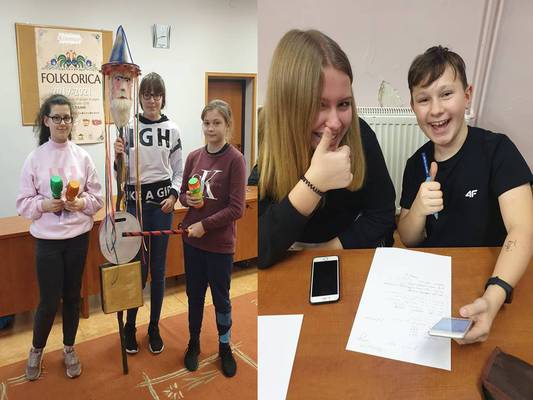

The Performance of a Traditional Song
In the framework of the project, the children from Apostolos Pavlou High School participated in a traditional song program, namely the selection activity. Then a song contest was held in the schools, where the pupils sang the traditional songs from the other countries and the best performance of a traditional song was rated. At our school, under the guidance of the teachers participating in the project, the pupils formed five groups, prepared and sang with enthusiasm five traditional songs chosen for them by the schools of Romania, Lithuania, Turkey, Spain and Poland. Afterwards, the songs were recorded and then the pupils of our school voted for them, grading them. The winner was the group that sang the traditional song of Lithuania, led by Mrs. Christia Charalambous, Professor of Home Economics.
Gabriella Theodosiou, teacher, Gymnasium Apostolou, Cyprus

I parástasi enós paradosiakoú tragoudioú
Sta plaísia tou érgou, ta paidiá apó to Gymnásio Apóstolou Pávlou symmeteíchan se éna paradosiakó prógramma tragoudión, diladí ti drastiriótita epilogís. Sti synécheia pragmatopoiíthike diagonismós tragoudioú sta scholeía, ópou oi mathités tragoúdisan ta paradosiaká tragoúdia apó tis álles chóres kai vathmologíthike i kalýteri apódosi enós paradosiakoú tragoudioú. Sto scholeío mas, ypó tin kathodígisi ton ekpaideftikón pou symmeteíchan sto érgo, oi mathités schimátisan pénte omádes, etoímasan kai tragoúdisan me enthousiasmó pénte paradosiaká tragoúdia pou epélexan gia aftá apó ta scholeía tis Roumanías, tis Lithouanías, tis Tourkías, tis Ispanías kai tis Polonías. Sti synécheia, ta tragoúdia ichografíthikan kai sti synécheia oi mathités tou scholeíou mas psífisan, vathmologóntas ta. Nikitís ítan to synkrótima pou tragoúdise to paradosiakó tragoúdi tis Lithouanías, me epikefalís tin ka Christia Charalambous, kathigítria Oikiakón Oikonomikón.
Christia Charalambous, dáskalos, Gymnásio Apostólou, Páfos
I parástasi enós paradosiakoú tragoudioú.pdf
Experience Exchange with "Székely Mikó" High School Pupils
Among the activities that schools can successfully develop and carry out, the most constructive, the most attractive and the most fun for the pupils of a school is the exchange of experience between two or even more schools. Such an exchange of experience took place in Sibiu, at the beginning of December 2019 between the Székely Mikó Theoretical High School in Sfântul Gheorghe and the “Consantin Noica” Theoretical High School in Sibiu, the host of the event. In order to complete an event of such magnitude, and for a favorable and pleasant development of events, it takes a lot of effort, trust and collaboration, good coordination and synchronization, good communication and relationship skills, impeccable organization, but especially a lot of teamwork and good cheer. Fortunately, all these features were indispensable in the organization and development of activities, and the action proved to be a real benefit for pupils of both high schools. After arriving in Sibiu, the guests from Sfântul Gheorghe were greeted with a lot of warmth and hospitality from Sibiu, and with a lot of joy. If on the first evening of their visit, the students from Sfântul Gheorghe enjoyed a well-organized and very special artistic and cultural program, supported by the pupils of the Theoretical High School "Constantin Noica", members of the Erasmus + project team "Folklorica", in the next day, they enjoyed a tour of the city of Sibiu, where they visited the main tourist, cultural and historical objectives that Sibiu has to offer. The purpose of this tour was to help pupils invited to understand why Sibiu is one of the most important medieval cities in Transylvania, to know what are the objectives and elements that make Sibiu a strong and very important focus of history and culture. Romanian and to enrich their knowledge and general culture with some more important and interesting information about the vast history of the city of Sibiu. The group of pupils from Sfântul Gheorghe being very large, was accompanied and coordinated both by the teachers from the Székely Mikó Theoretical High School and by the Romanian language and literature teacher, Petrina Dobrotă, as well as by some pupils of the 12th grade B of Noica High School: Denis Prodea, Vasile Șuiu, Cristina Chisă, Alexandrina Taran, Alex Bârsan, Bianca Lazăr, Andrada Popa. The organizer of the route and guide for the city tour was Rafael Țichindelean, a pupil in the 12th grade of philology. Our pupils promoted the Erasmus project and shared the experience gained so far in this wonderful project.
Petrina Dobrotă, teacher, “Constantin Noica” High School Sibiu

Schimb de experiență cu elevii Liceului "Székely Mikó"
Dintre activitățile pe care instituțiile școlare le pot elabora și realiza cu succes, cel mai constructiv, cel mai atractiv și cel mai distractiv pentru elevii unei școli este schimbul de experiență dintre două sau chiar mai multe școli. Un astfel de schimb de experiență a avut loc la Sibiu, la începutul lunii decembrie 2019 între Liceul Teoretic Székely Mikó din Sfântul Gheorghe și Liceul Teoretic ,,Constantin Noica” din Sibiu, gazda evenimentului. Pentru a duce la bun sfârșit un eveniment de o asemenea anvergură, și pentru o desfășurare favorabilă și plăcută a evenimentelor, este nevoie de mult efort, încredere și colaborare, o bună coordonare și sincronizare, o bună capacitate de comunicare și relaționare, o organizare impecabilă, dar mai ales multă muncă în echipă și voie bună. Din fericire, toate aceste trăsături au fost nelipsite în organizarea și desfășurarea activităților, iar acțiunea s-a dovedit a fi una cu adevărat benefică pentru elevii ambelor licee. După ce au ajuns în Sibiu, invitații din Sfântul Gheorghe au fost întâmpinați cu multă căldură și ospitalitate sibiană, și cu multă bucurie. Dacă în prima seară a vizitei lor, elevii din Sfântul Gheorghe s-au bucurat de un program artistic și cultural bine organizat și cu totul deosebit, susținut de elevii Liceului Teoretic ,,Constantin Noica”, membrii ai echipei proiectului Erasmus+ “Folklorica”, în cea de-a doua zi, aceștia s-au bucurat de un tur al orașului Sibiu, în care au fost vizitate principalele obiective turistice, culturale și istorice pe care Sibiul le are de oferit. Scopul acestui tur a fost acela de a-i ajuta pe elevii invitați să înțeleagă de ce Sibiul este unul dintre cele mai importante orașe medievale transilvănene, să cunoască care sunt obiectivele și elementele care fac din orașul Sibiu un puternic și foarte important focar al istoriei și al culturii românești și să își îmbogățească cunoștințele și cultura generală cu câteva informații mai importante și mai interesante despre istoria vastă a orașului Sibiu. Grupul de elevi din Sfântul Gheorghe fiind foarte numeros, a fost însoțit și coordonat atât de doamnele profesoare de la Liceul Teoretic Székely Mikó și de doamna profesoară de limba și literatura română, Petrina Dobrotă, cât și de câțiva elevi ai clasei a XII-a B ai Liceului Noica: Denis Prodea, Vasile Șuiu, Cristina Chisă, Alexandrina Taran, Alex Bârsan, Bianca Lazăr, Andrada Popa. Organizator al traseului și ghid pentru turul orașului a fost Rafael Țichindelean, elev în clasa a XII-a filologie. Elevii noștri au promovat proiectul Erasmus și au împărtășit experiența acumulată până acum în acest minunat proiect.
Rafael Țichindelean, elev, Liceul ,,Constantin Noica” Sibiu
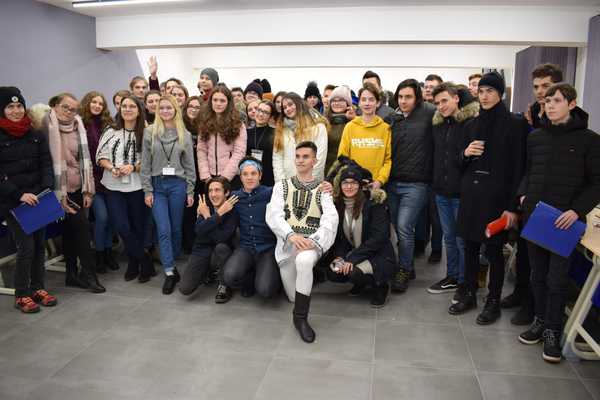
Conferința de leadership a elevilor din România
Cu siguranță, toți partenerii Erasmus, profesori și elevi, își amintesc plăcut de atelierele minunate și uimitoare dezvoltate împreună în Liceul „Betania”, parte a Liceului Teoretic „Constantin Noica” din orașul Sibiu, în timpul mobilității lor în România în cadrul proiectului „Folclorica”. Suntem mândri să vă spunem, prin intermediul acestui articol, că între 22 și 24 septembrie 2021, patru elevi ai Liceului „Betania” au participat la „Conferința de conducere a elevilor”, un interesant eveniment online organizat de Asociația Internaţională Școlilor Creștine. În cadrul acestei conferințe online, elevii au participat la câteva sesiuni plenare, ateliere, discuții de grup și alte activități, într-o experiență interculturală unică. La conferință au participat 24 de școli, respectiv 211 de elevi entuziaști și 40 de profesori din Olanda, Germania, România, Ungaria, Polonia, Albania, Lituania și Ucraina. Toți participanții la această conferință internațională online au colaborat perfect, fiind conștienți de faptul că nimeni nu este expert în, deoarece leadershipul este o practică, o abilitate care trebuie stăpânită zilnic, un proces al vieții.
Gabriela Mirela Jugar, coordonator, Liceul Teoretic „C. Noica”, Sibiu

Student Leadership Conference in Romania
Certainly, all Erasmus partners, teachers and students, remember pleasantly the wonderful and amazing workshops developed together in “Betania” High School, part of “Constantin Noica” Theoretical High School from Sibiu City, during their mobility in Romania within “Folklorica” project. We are proud to tell you, by means of this article, that between 22 and 24 September 2021, four students of “Betania” High School took part to the “Student Leadership Conference”, an interesting online event organized by the Association of Christian Schools International. Within this online conference, the students participated in a few plenary sessions, workshops, group discussions and other activities, in a unique intercultural experience. The conference was attended by 24 schools, respectively by 211 enthusiastic students and 40 teachers from the Netherlands, Germany, Romania, Hungary, Poland, Albania, Lithuania and Ukraine. All participants to this international online conference collaborated perfectly, being conscious that no one is expert in leadership, as leadership is a practice, a skill to be mastered daily, a process of a lifetime.
Oana Trinbițaș, English teacher in “C. Noica” High School, Sibiu
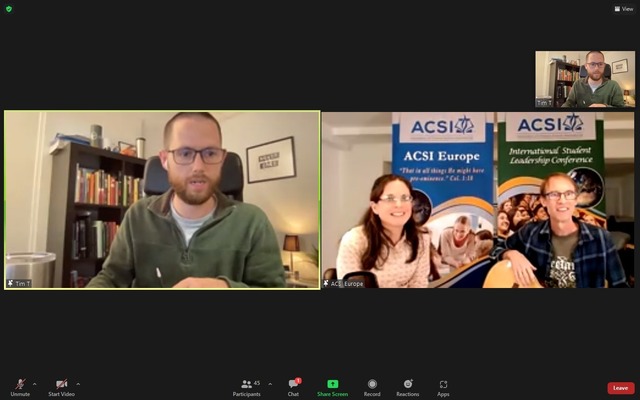
Ziua Europeană a Limbilor la Liceul “C. Noica” Sibiu
La Noica, de Ziua Europeană a Limbilor, împreună cu elevii claselor a V-a A și a V-a B ne-am salutat în engleză, franceză, germană și română, am exersat numerele, culorile, am călătorit în cultura și civilizația țărilor europene. Din cadrul cursurilor opționale de engleză-franceză și engleză-germană, nu au lipsit jocurile la care voluntarele din XI B filologie i-au ajutat pe micuți să învingă în ,”Războiul limbilor”. Și ca în orice poveste cu final fericit, copiii au demonstrat că spiritul de echipă, curiozitatea și buna dispoziție sunt valori ale europenilor fericiți chiar și “în vreme de război”.
Minodora Beza, profesor de franceză la Liceul “C. Noica” Sibiu, România
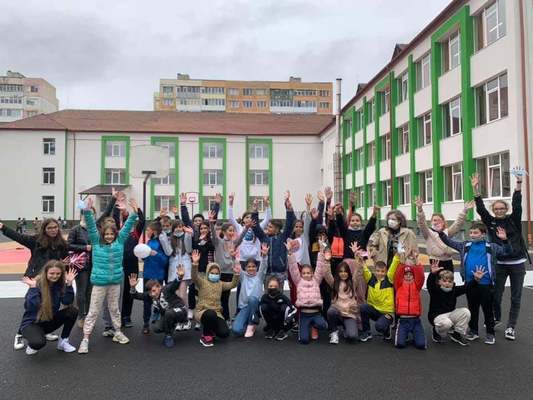

The European Day of Languages at “C. Noica” High School Sibiu
At Noica, on the European Day of Languages, together with the students of the 5th A and 5th B classes, we greeted each other in English, French, German and Romanian, we practiced the numbers, the colors, we traveled in the culture and civilization of the European countries. Among the optional English-French and English-German courses, there were games in which the volunteers from XI B philology helped the little ones to win the “War of Languages”. And as in any story with a happy ending, the children have shown that team spirit, curiosity and good mood are values of happy Europeans even “in time of war”.
Ileana Sînziana Salomie, English teacher in “C. Noica” High School Sibiu


Diagnose Test
Within the scope of the Erasmus+ project “Folklorica”, project team of teachers and workgroup of pupils have been formed to participate in the activities of project both at home and abroad. Volunteered teachers who undertook to participate to all activities were admitted to the team by filling the necessary forms. Fifty pupils chosen from many others formed the workgroup of project. In addition, to determine the teachers and pupils who were going to attend the mobilities, to know the level of pupils’ knowledge about partner countries and cultures, English and ICT tests were applied and those with the passing grade were chosen eligible for mobilities. Pupils at the workgroup were divided into sub-categories according to their interests. Each sub-group will contribute to the dissemination of the project by working on the field of interest.

Sümer Bulut, teacher Vali M. Lütfullah Bilgin Ortaokulu, Turkey
Teşhis Testi
Erasmus+ projesi "Folklorica" kapsamında, projenin yurt içi ve yurt dışındaki faaliyetlerine katılmak üzere öğretmenlerden oluşan proje ekibi ve öğrenci çalışma grubu oluşturulmuştur. Tüm etkinliklere katılmayı üstlenen gönüllü öğretmenler gerekli formları doldurarak ekibe kabul edildi. Diğerlerinden seçilen elli öğrenci proje çalışma grubunu oluşturdu. Ayrıca, hareketliliklere katılacak öğretmen ve öğrencileri belirlemek, öğrencilerin ortak ülkeler ve kültürler hakkındaki bilgi düzeylerini bilmek amacıyla ingilizce ve BİT testleri uygulanmış ve geçme notu olanlar hareketliliğe uygun olarak seçilmiştir. Çalışma grubundaki öğrenciler ilgi alanlarına göre alt kategorilere ayrıldı. Her alt grup, ilgi alanine göre çalışarak projenin yaygınlaştırılmasına katkıda bulunacaktır.

Ümit Gök, öğretmen Vali M. Lütfullah Bilgin Ortaokulu, Türkiye
Local Dances
Under the lead of sports teacher Aydın Acar, our folkloric dances team started trainings. They were learning two dances; one was local while the other was national. Folkloric team worked so much to be ready until the mobility in Gaziantep in 2021.
Yerel Danslar, teacher Vali M. Lütfullah Bilgin Ortaokulu, Turkey

Yerel Danslar
Spor öğretmeni Aydın Acar önderliğinde folklorik danslar ekibimiz eğitimlere başladı. İki dans öğreniyorlardı; biri yerel, diğeri ulusaldı. Folklorik ekip, 2021'de Gaziantep'teki hareketliliğe kadar hazır olmak için çok çalıştı.
Erkan Demirci, öğretmen Vali M. Lütfullah Bilgin Ortaokulu, Türkiye
Christmas Workshop 2021 in Romania
The pupils of Mrs. Gabriela Mirela Jugar made within the activity “Christmas Workshop 2021” Christmas cards dedicated to teachers and pupils in the school and in the Erasmus+ project “Folklorica” as well as personalized 3D globes with the names of all those who work in this high school, teachers and support staff. There was a commotion near the Christmas tree, each trying to find his/her name on the globe. They really liked the idea and the pupils and their teacher were congratulated. What do you say? Do you like the idea? If so, try again next year.


Oana Trînbitaș, teacher ”Constantin Noica” High School Sibiu, Romania
Atelier de Crăciun 2021 în România
Elevii doamnei Gabriela Mirela Jugar au realizat în cadrul activității ”Atelier de Crăciun 2021” felicitări de Crăciun dedicate dascălilor și elevilor din școală și din proiectul Erasmus+ ”Folklorica”, precum și globuri personalizate 3 D, cu numele tuturor acelora care lucrează în acest liceu, profesori și personal auxiliar. Era un adevărat freamăt lângă brad, fiecare căutând să își găsească numele pe globuleț. Ideea le-a plăcut foarte mult și elevii și învățătoarea lor au fost felicitați. Ce ziceți? Vouă vă place ideea? Dacă da, încercați anul viitor.

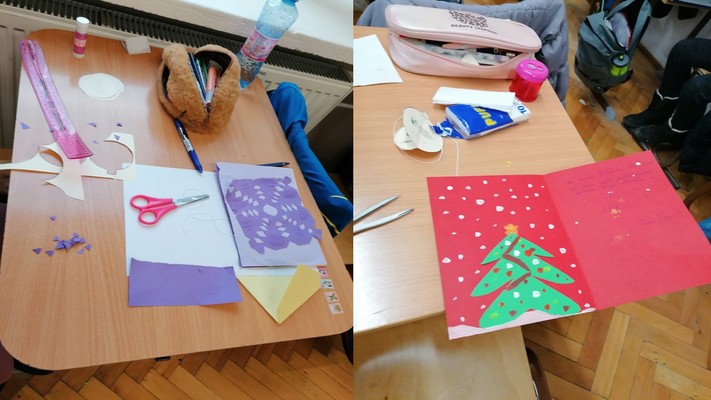
Petrina Dobrotă, profesor, Liceul ”Constantin Noica” Sibiu, România
Wicker and amber workshops by the Baltic Sea
Wickerwork is a Kashubian tradition, dating back to the Middle Ages, involving the processing of wicker, i.e. young shoots of several species of willows. It consists in the production of decorative and utility items, e.g. baskets, dishes, furniture, especially garden and beach furniture, fences and walls by braiding wicker. Our team had the opportunity to participate in weaving workshops. The students learned how wicker baskets and other items made of wicker are made. Each of the participants, under the watchful eye of the instructor, made a wicker decoration - a flower. The task was not easy, but the passion of those leading to work with this material and the ability to transfer knowledge by seniors made each participant successful. The participants also took part in the amber workshops. Amber is called the treasure or gold of the Baltic Sea, because the most famous of its varieties is found in these areas. According to historians, amber is a resin that leaked from ancient conifers when a forest grew in the place of today's Baltic Sea. The resin of trees growing on the ancient continent, about 40 million years later, turned into Baltic amber. The lecturer familiarized the participants with, among others, the methods of extracting amber, methods of its recognition and wide application. Apart from the fact that it is used to make original jewelery, it is also used in alternative medicine, pharmacy and cosmetics. Most often, however, it performs a decorative function, so the participants learned about the techniques of processing amber and made some amber ornaments by themselves. It turned out that cultivating similar traditions is extremely important, not only to keep them in mind, but also to develop the imagination, creativity and young people ingenuity.
Mariola Podolska-Maculewicz, project coordinator, Szkoła Podstawowa Nr 2 im. Nidzicy
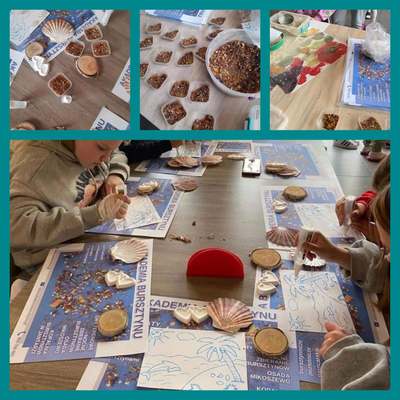
Warsztaty wikliniarskie i bursztynnicze nad Bałtykiem
Wikliniarstwo to tradycja kaszubska, sięgająca średniowiecza, obejmująca przetwórstwo z wikliny, czyli młodych pędów kilku gatunków wierzb. Polega na wyrobie przedmiotów ozdobnych i użytkowych, np. koszy, naczyń, mebli, zwłaszcza ogrodowych i plażowych, płotów i ścian poprzez zaplatanie wikliny. Nasz zespół miał okazję uczestniczyć w warsztatach plecionkarskich. Uczniowie dowiedzieli się, jak powstają kosze wiklinowe oraz inne przedmioty tworzone z wikliny. Każdy z uczestników, pod czujnym okiem instruktora, wykonał samodzielnie ozdobę wiklinową – kwiat. Zadanie nie było łatwe, ale zamiłowanie prowadzących do pracy z tym materiałem oraz umiejętność przekazywania przez seniorów wiedzy, sprawiło, że działanie każdego uczestnika zakończyło się sukcesem. Uczestnicy wzięli również udział w warsztatach bursztynniczych. Bursztyn nazywany jest skarbem lub złotem Bałtyku, gdyż najbardziej znana z jego odmian występuje właśnie na tych terenach. Według historyków bursztyn jest żywicą, która wyciekła z pradawnych drzew iglastych, gdy w miejscu dzisiejszego Morza Bałtyckiego rósł las. Żywica drzew rosnących na pradawnym kontynencie, około 40 milionów lat później, przerodziła się w bursztyn bałtycki. Prowadzący zaznajomił uczestników m.in. z metodami wydobywania bursztynu, sposobami jego rozpoznawania oraz szerokim zastosowaniem. Prócz tego, że powstają z niego oryginalne wyroby biżuteryjne, jest również wykorzystywany w medycynie niekonwencjonalnej, farmacji i kosmetyce. Najczęściej jednak pełni funkcje ozdobne, dlatego uczestnicy poznali techniki obrabiania bursztynu oraz własnoręcznie wykonali kilka bursztynowych ozdób. Okazało się, że pielęgnowanie podobnych tradycji jest niezwykle ważne, nie tylko dla zachowania ich w pamięci, ale także rozwijania wyobraźni, twórczości i pomysłowości młodych ludzi.
Dorota Kosińska, Ewa Hinburg teachers, Szkoła Podstawowa Nr 2 im. Michała Kajki w Nidzicy
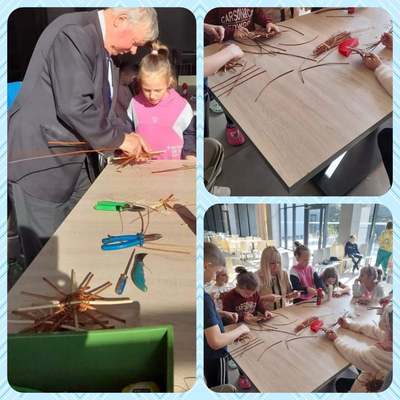
Spring Events
Les Dynamiques de Noica combined, at the French workshop, spring events: Le Poisson d’Avril, the Easter fast (le carême des Pâques), the chocolate egg hunt (La chasse des œufs en chocolat). Each moment brought joy to the students participating in VI B class and cultural richness.
Dana Bratu, teacher in ”Constantin Noica” High School Sibiu

Evenimentele primăverii
Les Dynamiques de Noica au îmbinat, la atelierul de franceză, evenimente ale primăverii: Ziua Păcălelii (Le Poisson d’Avril), postul Paștelui (le carême des Pâques), Vânătoarea de ouă de ciocolată (La chasse des œufs en chocolat). Fiecare moment a adus bucurie elevilor participanți din clasa a VI-a B și bogăție culturală.
Minodora Beza, profesor al Liceului Teoretic ”Constantin Noica” Sibiu

The Workshop of the Sturdy - May 31, 2022
Certainly, the activities with young children have their special charm. The secret of a safe success is the balance between play and learned content. It is great to see how ultra the digital generations are, in fact, passionate readers, willing to show those around them that reading makes them feel free. It is true that the role of catalyst of the teacher is essential in stimulating the pleasure of reading, but the family also creates the conducive environment to stay with the book in the hand like the sturdy of Petre Ispirescu. In the future, I propose that the study of the text will generate ideas with applicability in real life. The fairy tale can also be a pretext for x -raying the world in which we live. With applause, for the 4th class A in “Constantin Noica” Theoretical High School Sibiu!
Gabriela Mirela Jugar, coordinator ”C. Noica” High School Sibiu


Atelierul Voinicului - 31 mai 2022
Cu certitudine, activitățile cu copiii mici au farmecul lor aparte. Secretul unei reușite sigure constă în echilibrul dintre joacă și conținutul învățat. Este minunat să vezi cum generațiile ultra digitale sunt, de fapt, cititori pasionați, dispuși să arate celor din jur că lectura îi face să se simtă liberi. E drept că rolul de catalizator al doamnei învățătoare este esențial în stimularea plăcerii de a citi, dar și familia creează mediul propice de a sta cu cartea în mână asemenea voinicului din basmul lui Petre Ispirescu. Pe viitor, propun ca studiul textului să genereze idei cu aplicabilitate în viața reală. Basmul poate fi un pretext și pentru radiografierea lumii în care trăim. Cu aplauze, pentru clasa a 4-a A din Liceul Teoretic ,,Constantin Noica” Sibiu!
Petrina Dobrotă, profesor, Liceul ”C. Noica” Sibiu, România
